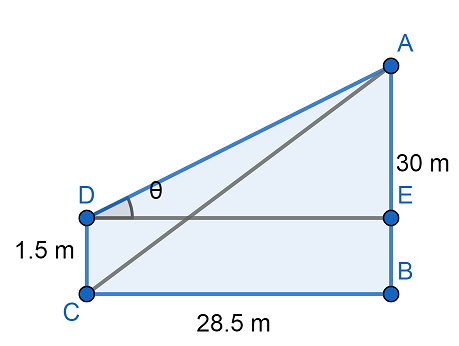
An observer, 1.5 m tall, is 28.5 m away from a tower 30 m high. Determine the angle of elevation of the top of the tower from his eye.
Answer
555.9k+ views
Hint: To solve this question first we need to draw a diagram. We will use the trigonometric ratios and trigonometric functions to solve this question. We will use $ \tan \theta =\dfrac{\text{perpendicular}}{\text{base}} $ then substitute the values and solving
Complete step by step answer:
We have been given that an observer, 1.5 m tall, is 28.5 m away from a tower 30 m high.
We have to find the angle of elevation of the top of the tower from his eye.
Let us draw a diagram using the given information.

Here in this diagram let us assume that DC is the height of the observer which is given $ DC=1.5m $, the height of tower $ AB=30m $, the distance between observer and tower $ BC=28.5m $.
Now, let us assume the angle of elevation of the top of the tower from the eye of the observer will be $ \theta $.
Let us consider $ \Delta ADE $ ,
We know that $ \tan \theta =\dfrac{\text{perpendicular}}{\text{base}} $
Substituting the values we get
$ \begin{align}
& \Rightarrow \tan \theta =\dfrac{AE}{DE} \\
& \Rightarrow \tan \theta =\dfrac{AB-BE}{DE} \\
\end{align} $
Now, from diagram we have DE=BC and DC=BE (parallel lines)
So, we get
$ \Rightarrow \tan \theta =\dfrac{AB-BE}{BC} $
Now, we have $ AB=30m $ , $ BC=28.5m $ , $ BE=1.5m $
Substituting the values we get
$ \Rightarrow \tan \theta =\dfrac{30-1.5}{28.5} $
Now, solving further we get
$ \begin{align}
& \Rightarrow \tan \theta =\dfrac{28.5}{28.5} \\
& \Rightarrow \tan \theta =1 \\
\end{align} $
Now, we know that $ \tan 45{}^\circ =1 $
So, we get
$ \begin{align}
& \Rightarrow \tan \theta =\tan 45{}^\circ \\
& \Rightarrow \theta =45{}^\circ \\
\end{align} $
So, the angle of elevation of the top of the tower from the eye of observer is $ 45{}^\circ $ .
Note:
Students can assume the angle of elevation at point C which is incorrect. As we have asked in the question that we have to find the angle of elevation from the eye of the observer and the observer is not a point object. So keep this in mind and solve the question carefully.
Complete step by step answer:
We have been given that an observer, 1.5 m tall, is 28.5 m away from a tower 30 m high.
We have to find the angle of elevation of the top of the tower from his eye.
Let us draw a diagram using the given information.

Here in this diagram let us assume that DC is the height of the observer which is given $ DC=1.5m $, the height of tower $ AB=30m $, the distance between observer and tower $ BC=28.5m $.
Now, let us assume the angle of elevation of the top of the tower from the eye of the observer will be $ \theta $.
Let us consider $ \Delta ADE $ ,
We know that $ \tan \theta =\dfrac{\text{perpendicular}}{\text{base}} $
Substituting the values we get
$ \begin{align}
& \Rightarrow \tan \theta =\dfrac{AE}{DE} \\
& \Rightarrow \tan \theta =\dfrac{AB-BE}{DE} \\
\end{align} $
Now, from diagram we have DE=BC and DC=BE (parallel lines)
So, we get
$ \Rightarrow \tan \theta =\dfrac{AB-BE}{BC} $
Now, we have $ AB=30m $ , $ BC=28.5m $ , $ BE=1.5m $
Substituting the values we get
$ \Rightarrow \tan \theta =\dfrac{30-1.5}{28.5} $
Now, solving further we get
$ \begin{align}
& \Rightarrow \tan \theta =\dfrac{28.5}{28.5} \\
& \Rightarrow \tan \theta =1 \\
\end{align} $
Now, we know that $ \tan 45{}^\circ =1 $
So, we get
$ \begin{align}
& \Rightarrow \tan \theta =\tan 45{}^\circ \\
& \Rightarrow \theta =45{}^\circ \\
\end{align} $
So, the angle of elevation of the top of the tower from the eye of observer is $ 45{}^\circ $ .
Note:
Students can assume the angle of elevation at point C which is incorrect. As we have asked in the question that we have to find the angle of elevation from the eye of the observer and the observer is not a point object. So keep this in mind and solve the question carefully.
Recently Updated Pages
What happens to glucose which enters nephron along class 10 biology CBSE

Write a dialogue with at least ten utterances between class 10 english CBSE

A circle is inscribed in an equilateral triangle and class 10 maths CBSE

When the JanmiKudian Act was passed that granted the class 10 social science CBSE

A sector containing an angle of 120 circ is cut off class 10 maths CBSE

The sum of digits of a two digit number is 13 If t-class-10-maths-ICSE

Trending doubts
The shortest day of the year in India

Why is there a time difference of about 5 hours between class 10 social science CBSE

Write a letter to the principal requesting him to grant class 10 english CBSE

What is the median of the first 10 natural numbers class 10 maths CBSE

The Equation xxx + 2 is Satisfied when x is Equal to Class 10 Maths

What is the missing number in the sequence 259142027 class 10 maths CBSE




